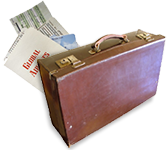Mika Pyyhkala, a long time TravelCommons listener who works for the National Federation of the Blind of Massachusetts, dropped me a note about a problem he recently had with some new technology installed in New York City cabs.
“I was in NYC last Sunday and I took a taxi from La Guardia airport to mid town Manhattan. I noticed that the credit card payment terminal is a touch screen visual-only interface. The taxi driver had to get into the back seat to read and operate the system for me — I could not tell what was on the screen. You cannot just swipe the card; you have to press the touch screen a number of times to initiate and complete the transaction, including pressing an area to select your tip amount. The driver told me the tip options were 20% or 25%, but I am sure it also has an option for 15%.”
There’s an uncomfortable situation — trusting your cab driver to select his own tip before he’s pulled your luggage from his trunk. I’ve used these credit card terminals and they’re one of the worst payment interfaces I’ve experienced — a complete pain for someone with good eyesight. I’ve stayed with cash ever since. Mika’s note, however, suggests a challenge to the travel industry’s broader moves toward self-service. As airlines and hotels work to move more transactions to touch screen kiosks at the same time as an aging population’s eyesight dims, good accessibility design will become critical to the success of these self-service initiatives — a lot more important than a pleasing color palette.
1 comment on “Need Some Texture on Those Touchscreens”
Comments are closed.

This is an example of an accessible kiosk design. I have used the Amtrak kiosk in several cities to complete a number of different transactions using the tactile buttons and spoken audio output:
http://trace.wisc.edu/handouts/ez-intro/
The Washington DC Metro subway system:
http://metroopensdoors.com
also has accessibility features built in to at least 1-2 fare vending machines in each station. You simply press an audio button which by the way is labeled in both Braille and print and the system provides voice prompts throughout the interface including functions like checking your SmarTrip card balance.
The Boston subway system:
http://mbta.com
also has some spoken accessibility features in their fare vending machines, although the last time I tested it a year or so ago, there were several glitches including errors in how the audio menus were presented and no ability to check your CharlieCard or CharlieTicket balance via the audio interface. It is important that an accessible interface provide the user with the same types of transactions and features as the visual interface. Its also important that such interfaces are beta tested for both accessibility and usability by actual blind users.
Of course we would like to see the airlines and hotels adopt accessible kiosk technology, and this is expected to be the subject of a future DOT NPRM:
http://airconsumer.ost.dot.gov
In the latest revision of the implimenting regulation of the Air Carrier Access Act, ACAA, known as Part 382, DOT will require that carriers provide accommodations to ensure that people unable to use the kiosks are given expedited access to ticket counter personell. I think they are going to suggest that carriers implement this by allowing people unable to use the kiosk to access the first class line at the ticket counter even if said passenger does not have elite status on that particular carrier.
A partial work around to the inaccessible airline touch screen kiosks is to use web check in which works with most computer screen reader applications such as:
http://hj.com/jaws
http://accessibilityisaright.org
I use web check in about 95% of the time when I fly to bypass the ticket counter.
A local NYC advocacy group is apparently working to address the situation with the inaccessible NYC taxi touch screen system:
http://www.nytimes.com/2007/12/15/arts/television/15watc.html
I will add a comment when I learn more about this effort.